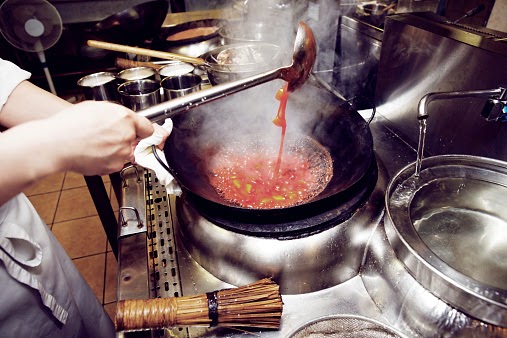Splattering grease...vats of hot oil…open flames…steaming food. With the demands of high-volume cooking, it’s no wonder the
foodservice industry has the highest incidence rate of heat burns of any
employment sector, according to the U.S. Bureau of Labor Statistics. These
injuries can be costly for employees and your business, leading to absenteeism,
higher workers’ compensation costs, lower morale and increased employee
turnover.
To keep employees safe and contain your costs, perform
periodic safety audits. Step through your restaurant, and identify burn risks
and ways to mitigate them.
Front of the house
Heat lamps and heat
strips. Be careful when removing plates or containers from these
heated areas to avoid contact with hot surfaces.
Hot dishes. Use
trays, hot pads, oven mitts or dry waiter’s cloths to help carry and serve.
Candlelit tables. Walk
around the table if necessary to pick up a plate, rather than reaching over the
flame.
Coffee pots, hot
water dispensers. Take caution when preparing and serving hot drinks;
don’t remove a coffee pot until all the liquid is dispensed.
Back of the house
Fryers. Deep-fat
fryers are the top cause of burns in restaurant kitchens, according to federal
government’s Occupational Safety & Health Administration.
- Use the correct grease level to help prevent splatters; never pour past the “fill line.”
- Cook at the manufacturer’s recommended temperatures. Don’t overheat the oil.
- Gently raise or lower fryer basket while cooking to avoid splashing.
- Handle only one fryer basket at a time.
- Don’t overfill fryer baskets, which can cause the hot oil to splash or bubble over.
- Remember: oil and water don’t mix. Dry fryer and fryer baskets after washing with water to avoid splatters. Don’t allow excess ice crystals from frozen foods to get into the cooking oil.
- Don’t stand too close or lean over hot oil.
- Let oil cool before moving or straining it.
- Before cleaning the overhead vents, wait for the fryers to cool and cover fryer bins. Do not allow workers to stand on a fryer; use a ladder or stepstool.
- Place nonslip floor mats around fryers to reduce the chance of slipping and falling onto the frying equipment.
- Provide protective mitts and gloves here and elsewhere in the kitchen as needed. Never use wet materials as potholders.

Stovetops, Grills
- Clean grill and stove surfaces to prevent grease flare-ups.
- Adjust burner flames to the proper level. On stovetops, they should cover only the bottom of the pan.
- Avoid filling pots too high.
- Place foods carefully into hot water to avoid splashing.
- Ensure lids are tight-fitting and handles are securely attached to vessels that contain hot liquids.
- Be careful when moving or carrying a heavy pot of hot liquid off the stove. Ask for help if needed. Make sure you transfer the pot to a place that can hold it steady.
- If transferring hot liquids using a rolling cart, ensure that the container is secure and will not tip or spill.
- Use proper cooking tools, such as tongs, to prevent contact with hot surfaces and foods.
- Don’t reach above an oven or steamer; steam can burn.
- Don’t open cookers and steam ovens when they are under pressure.
- Open ovens or steamers by standing to the side, keeping the door between you and the open steamer.
- When steamers are stacked, open the top steamer first to prevent burns from the rising steam.
Emergency prep. No
matter how may precautions you take, occasional burns are inevitable. Train
employees in basic first
aid for burns and instruct them to seek medical treatment and call 911
if necessary.


No comments:
Post a Comment